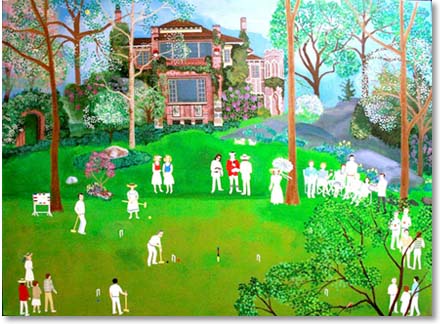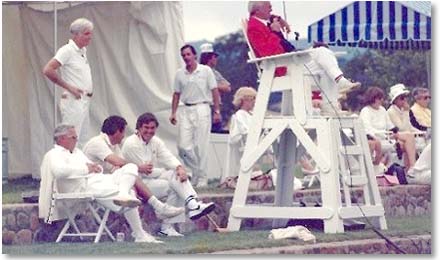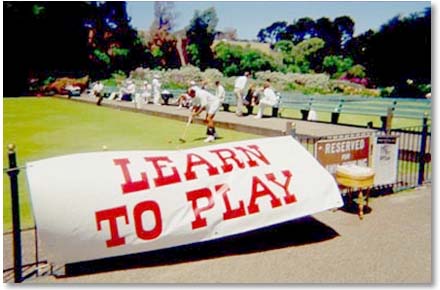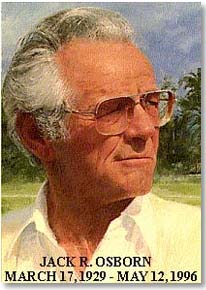

|
Back to |
| The Front Page |
| Letters & Opinion |
|
Good News / Bad News about Croquet in America By Bob Alman |
||||||||||
|
||||||||||
The bad news is, of course, that not many of the original boosters of the sport are left to inject millions of dollars into new facilities. Forty years ago, there was not even one dedicated croquet lawn as we know them today; now there are about 400 regulation courts, and that's not counting courts shared with other tennis or bowling--so that's the good news. The organization, despite ups and downs, has kept membership numbers above 3,000 nationally; and the Croquet Foundation of America has managed to keep finances on an even keel at the gorgeous Florida headquarters that is still the world's "croquet mecca" and where everybody of any class wearing any costume can come (please, no heels!) and learn to play.
I first met Jack Osborn in the mid-eighties at the Arizona Open and told him how excited I was about the prospects of public courts in San Francisco and throughout the land. He gave me a cold look and said brusquely as he turned away, "In this country, croquet is a sport for the elite class."
And it really was, back then, because that's the way he created it.

|
| Patricia and Fred Supper epitomized the ideal of Jack Osborn's USCA: so fabulously wealthy they could build their own courts--like this one at the Supper's summer residence in Greenwich, Connecticut; as well as donate to the croquet establishment, as Patricia did in giving the Croquet Foundation of America a donation sufficient for "naming rights" for the upstairs ballroom at the National Croquet Center. The painting is from the National Croquet Gallery, housed at the Center. |
It's much too soon to write my own memoir, but the recent publication by the USCA of it's 40-year retrospective has jolted me into a response. The USCA NEWS history is well and thoroughly done, and yet it suggested that the USCA headquarters facility--the National Croquet Center--was not completed until 2008. It's an understandable oversight--10 years is a long time to remember what happened, and not everyone reads Croquet World. But in fact, the USCA staff, housed with my own office in the Center's maintenance shed, waiting for the clubhouse to be completed and for a Certificate of Occupancy, moved into the completed and fully furnished clubhouse in early May of 2002.

|
| When Sonoma-Cutrer was built in the mid-eighties, California players called it "croquet heaven" and in short order the USCA's 1985 Western Regional was played there. But when Jack Osborn brought along his referee chair and installed it between the two stone-lined courts, Brice Jones (seating and smiling, third from left above) was reportedly offended to have an outsider presiding in a "throne" in the middle of his own territory. Osborn was never invited back. Photo courtesy of Mike McDonnell. |
Who should run the USCA's headquarters facility?
Chuck Steuber's stroke more than six months before the clubhouse was occupied ended his role as the manager and financer of the Center. Because it was the national headquarters of the USCA, some believed that the USCA should have the main voice in how it was run and so a succession of people were enlisted to tell me what to do while others insisted in vain, "Just let Bob do his job." My "advisors"--however well-intentioned--were not interested in my development plan and thought they needed to give me ad hoc direction about what needed to be done.
Lots of shouting matches occurred in the maintenance shed office I shared with Archie Peck and my membership director in late 2001 and early 2002. More than once, I had to say, "I can't take this any more," and that was when we were planning to host the first WCF world championship at the Center in February of 2002, which Chuck had agreed to finance as our way of promoting the Center to the world. Tony Hall and I had made a "gentleman's agreement" in San Francisco during one of his WCF presidential tours to confirm the date.
It was the first Golf Croquet World Championship in America, and the first WCF title event for 80 players. It seemed to me at the time that the USCA committee--headed by "bad boy Mehas"-- did everything they could to screw it up. They told Tony Hall at one point not to communicate with me at all. (He responded bluntly but politely, "I'm going to continue to communicate with the manager of the host facility....")
This committee, incredibly, declined the offers of many competent and experienced golf croquet referees around the world to come at their own expense and referee. Instead, the USCA appointed a well-intentioned local croquet bigwig to "train" a corps of volunteer referees--mostly people who actually played Golf Croquet, but not at a high level.
This USCA committee, incredibly, neglected to select all 80 players allotted and instead cancelled the Qualifying tournament and invited them all to play in the main event.
Despite all this, I orchestrated an elegant Opening Day, with much ceremony--including for a brass quartet for fanfares and a 60-member chorus to underscore the celebration. As it happened, record-breaking rainfall marred the opening day, and the assistance of Anne Frost-Robinson, visiting from Canada, turned out to be crucially important in making everything work--including moving the performances and ceremonies inside to the Festival Tent attached to the maintenance shed.

|
| In March of 2003--two months before the clubhouse could be legally occupied--the 10-acre Center was already alive with major events, including play on the "dry retention area" for half-court Golf Croquet. In a financial crunch around 2007 this lawn was ruined with discarded bio-debris and only now--in 2018--is being restored as a good playing surface. |
Despite what surely must be the poorest quality of refereeing ever allowed in a major WCF event, it all worked out. At that time, the Egyptians probably deserved to win the top four places--although I had private doubts about a refereeing call against Reg Bamford in the quarter-finals knockout.
Filling in some critical blanks
An official history cannot be blamed for failing to mention the disastrous succession of managers of the USCA HQ that followed Bob Alman's departure in the middle of 2003, and it very properly gives due credit to David McCoy for putting the headquarters facility on an even financial keel since taking over the presidency of the Croquet Foundation of America, the Center's owner. in 2009.
But I hope to be forgiven for filling in some of the blanks that we now know were created by the mysterious disappearance of all the Center's membership records, both digital and hard-copy, during the administration of my immediate successor, who had fired my membership director early on and who suddenly decamped with his family to Australia before the end of the season and before he could be prosecuted.
At this point, we might quote from a May 2007 CROQUET WORLD article:
"After the departure in July of 2003 of Bob Alman, who had started promoting club enrollments in late 2000 and opened the club on the completed lawns in December of 2000, there was virtually no pro-active onsite marketing and development until Mike Jenner was hired in the spring of 2004. By the time Jenner started his one-year tenure in the spring of 2004, the membership structures vital for development had already been fatally compromised in various ways, and Jenner make it clear to everyone that "membership is not the priority." Jenner concentrated on event marketing and cutting expenses. By the end of Jenner's one-year tenure, membership activities and morale were at an all-time low. Jenner had eliminated the novice-level "associate" membership, which had been the driving engine of membership growth for two years. Membership numbers began a precipitous decline.Steuber had told Alman in 2000, "Give yourself the title and the salary you need," and that salary was little more than half what the subsequent managers were paid--the then prevailing "club manager" rate of $64,000."The next manager was chosen with all good intentions from the sphere of professional club management, but unfortunately he had no experience in marketing and development; his solution to problems and challenges was to hire somebody to do them, and he hired people who couldn't do the job. His highest priority was restoring the growth of membership, and he failed in that task. His contract was not renewed in the spring of 2006.
"Backed by tremendous personal popularity and a good showing on the USCA Planning Committee, Terry Colbert was engaged as General Manager in the summer of 2006, charged with the single over-riding priority of building membership. Colbert was unsuccessful in achieving significant growth results, despite a high level of energy and enthusiasm, and despite excellent work in improving Center graphics and print pieces.
"On Colbert's behalf, it must be said that he inherited a membership program in a complete shambles, and he was making some headway in repairing the damage by restoring the original membership structures and categories that had supported the club initially to the level of 350. But as of May 1, 2006, with membership around half its peak numbers of three years earlier - at only 175 - and with expenses mounting, the Foundation Board, after much deliberation, found it could not justify the enormous expense of the General Manager job as it has been structured for the previous General Manager cycles."
But those are mere numbers, and this story is not really about membership numbers of the headquarters facility or of the USCA. It's written to note a truly remarkable shift in the nature of the core membership of the national association in America.
A seismic shift in the culture
When I moved to Florida in 2000 to organize and manage the new national headquarters facility, croquet in America was still, to a large extent "a sport for the affluent class." Jack Osborn, the brilliant entreprenuer who created the USCA, had told me this at the Arizona Open, only fifteen years before Steuber hired me. I had wanted to tell him how excited I was about persuading the city of San Francisco to build two public courts for our club in a city park. It would be the first in the country, and.... But instead of being pleased, he was clearly annoyed.

|
| The two-court San Francisco Croquet Club was for many years--throughout the 90's--the national model of the successful croquet club on public turf--a genuinely public croquet club, supporting the park department, renting extra lawns from the bowlers, fulfilling a yearly cash pledge to the City, donating a free weekly "senior croquet" event, producing youth programs for high schools, and casting a wide net to the public to encourage genuinely youngish athletes, who quickly mastered the game. The banner at the bowling lawns in Golden Gate Park in play during the San Francisco Open is flanked by a small table with fliers promoting a free Saturday Introduction to Croquet on the Stern Grove Lawns. |
At that time--more than 30 years ago, less than a decade after the USCA's founding--it was much too soon to have people believe that just anybody could play the sport of croquet.
Osborn, coming out of the world of advertising in Manhattan, had cobbled together the unique American Rules in a compromise among the five founding clubs, and then wisely chose to publicize croquet as a sport for the wealthy. This was easy to do because it was actually true, thanks to the Swopes' popularizing croquet among the celebrity set in the 20's and 30's, including the Hollywood elite. In large part, "a sport for the affluent class" was a self-fulfilling prophecy. The wealthy, after all, had the money to build courts and to get them built or designated at country clubs and resorts. And the celebrities drew plenty of press to help him promote "the fastest-growing sport in America."
Ironically, the "flagship" club of the USCA for many years was the New York Croquet Club in Central Park, founded by Osborn with the considerable assistance of Joseph Tankoos and others well known to the city administration. The first nine national championships were played there on it's public lawns. It is still an important croquet club, although its two lawns are still shared with bowlers, on public turf.
The San Francisco Croquet Club--which I successfully re-organized and expanded on public turf with my very gifted and supportive board--also began on public turf, through the influence of wealthy and influence socialites, including Steve Swig, whose family owned the Fairmont Hotel, ably assisted by Tom McDonnell. That's where the resemblance with the East Coast establishment ended.
Despite Osborn's apparent scorn for "public court croquet," the San Francisco Croquet Club succeeded hugely as a club which welcomed anyone, visibly and loudly. It was for many years the only club on public turf with two built-for-croquet courts. It attracted young and sporty players who became national champions. For a half-dozen years in the 90's, its 64-person open tournament on as many as seven lawns was stronger in player strength than the USCA nationals on the East Coast.
"Western Killers" pressed for change
The San Francisco Croquet Club, acknowledged for a decade as "the club of champions" was also a strong focus for Osborn's verbal violence against us, in the late eighties, with words like "Western Killers." His editorial on the subject in the USCA Croquet Gazette was probably the one thing that finally brought him down as president of the organization he so brilliantly founded and developed.

|
A few years later, when he died, I wrote an editorial that described as well as I could who he was and what he achieved, along with the aspects of a personality that could sometimes be rough. I have been gratified to find that my obituary is the most quoted and reprinted. It constitutes the entire Wikipedia entry on Osborn, verbatim, albeit unattributed. (My policy has been to NOT write an obit on a croquet personage unless it can be reasonably accurate and complete in my experience. Thus I have written obits on Osborn, Ellery McClatchy, Chuck Steuber, and others, but not on other figures with whom I worked whose interesting flaws were very much a part of their personae, vitally relevant to how they lived their lives, but not widely known. For them, I only linked to the tributes others wrote about them, from this magazine's home page.
Perhaps Chuck Steuber had intended that the National Croquet Center serve as a bridge to the "public" for our sport. He never talked about his ultimate purposes. He tended to pick people to do the work and trusted them to do what needed to be done. Virtually all the croquet players in Palm Beach County seemed pleased with the Center, and many members of the more private facilities accepted our offer of a special "affiliate" membership at the National Croquet Club, or were party to a "reciprocal membership benefit"--including Donald Trump's Mar-a-Lago.
The private clubs--the Beach Club, PGA National, and the Palm Beach Croquet Club--all started to rent the lawns of the NCC to expand their own invitationals, retaining the highlights at their own venues. So their members would come to the Center to watch some of the games in those invitationals, or to witness a major international event.
Somewhere around the spring of 2003, I chatted on the veranda with a well-known red-haired socialite there to watch a major event. The subject was membership. When I asked, she explained simply, "The reason I haven't joined is that they let the public in here." Her wealthy Palm Beach husband had discovered her in a Manhattan chorus line. She never became a member of the Center. She has since passed away.
As recently as 2008,. the Palm Beach Invitational had 66 players plus 25 SOCIAL participants--that's 90 paid participants. That was the first year the entire event was played at the Center, including the finals. The club membership has now joined the NCC and virtually surrendered their historic single court in front of the Breakers Hotel.
That "merging" of the membership of the venerable Palm Beach Croquet Club with the membership of the National Croquet Center several years ago is perhaps symbolic of the remarkable melding of the middle- and upper-class croquet playing population of the entire country.

|
| Flash forward 15 years, and you see a National Croquet Center organized to do everything necessary to promote the sport to everyone--whether they're wearing white or not--including having an elegant dinner on the veranda heated by portable units whose only purpose is to warm outdoor dining during rare periods of cool weather in South Florida's mild winter. In the distance a few people are preparing to play Golf Croquet under lights. Photo courtesy of the National Croquet Center. |
There are now many more "open" tournaments than "invitationals" in America and some of the best-run events are played at large facilities that are either public or built and managed by entrepreneurs who welcome anyone with the price of membership to their lawns. Florida's seven-lawn Sarasota County Croquet Club, comes to mind, as well as Macey Whites' extraordinarily complete eight-lawn club at Chesapeake Bay, where the 2018 American Rules nationals are being played.
Most of the members of "the elite class" who helped Osborn make the USCA viable are gone now. Some of them were vitally important to Osborn and the sport in the early days, when an American croquet association was no more than an idea, with no courts to make it real. All of that has changed. Croquet is now as well established in America as it is in Britain. And anyone is welcome to play.
One of the string of impressive women--ladies who used their money and their social capital and sometimes their administrative expertise in service to his organization--told me in confidence, much later. "Jack's long-range vision always included public courts."
If that is true, Osborn vision has been fully realized, coast to coast, with a mix of middle class players and wealthy self-made millionaires who continue to contribute their money and their skills to croquet affairs that benefit us all.
|
LOOKING FOR MEMOIRISTS: BY THOSE WHO SAW IT AND DID IT The author, in his 79th year, is contemplating writing a much more complete and inclusive croquet memoir than the deliberately fragmentary recollections needed for this account. It can be done after a few more people have died or moved to another continent. Comprehensive histories for the other major countries should also be undertaken by principals in the action in the other major croquet-playing countries while they are still alive, informed by their own certain knowledge and point of view. But the story above illustrates the best reason for doing it: that "official" histories by properly self-interested organizations and persons--no matter how competently done--cannot absolutely be trusted. So this is an invitation to croquet personalities everywhere--and especially in Australia and New Zealand, but also in England, because a lot has happened since Pritchard's admirable history was published in 1981, to write down those recollections. You will be able to describe what happened and what didn't from their own point of view, because you were there, observing, participating. OF COURSE one's memory also cannot be totally trusted either, and any single point of view is not authoritative. But in subjecting one's recollections to public view, the exposure might contribute to something resembling a genuine HISTORY of a time and place that might approach "the truth" as finally compiled from many sources by a future historian. Those histories would incorporate the official histories prepared by the organizations themselves as well as media accounts from the times and other contemporary documents. We have passed through an age of "personal journalism" after all, and when you put the label of "memoir" on a piece of writing, that is apology enough for whatever personal skew you give it, from your own point of view. It's the personal skew that is liable to be not only the most interesting part, but also the most relevant in the future figuring out of historical scholars of how such a thing could possibly have happened! We were pleased to edit and publish the excellent three-part croquet memoir of the legendary player John Prince. We printed here John Solomon's valedictory speech. We want to do more personal recollection in CROQUET WORLD. The next such memoir we hope to publish will be that of the Australian Neil Spooner, whose 25-year croquet career included being the first "pro" hired from overseas to direct croquet at a new US facility for Brice Jones. Neil managed the first series of "world championships" of our sport at Sonoma-Cutrer in Northern California, in the 80's and 90's. What's YOUR story? |